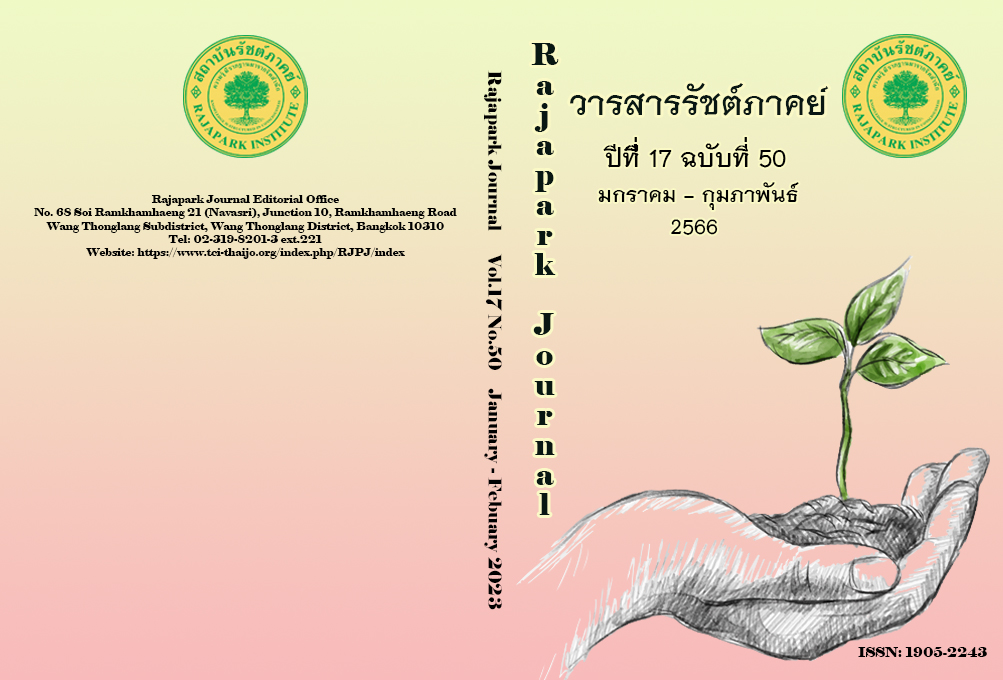Factors Influencing Customer Loyalty to Coffee Shops in Pranakhon Si Ayuthaya Province
Main Article Content
บทคัดย่อ
The objectives of this research were to 1) investigate the level of coffee shop factors: product quality, service quality, physical environment, brand innovation and customer loyalty in Pranakhon Si Ayuthaya Province 2) study relationship among the coffee shop factors and customer loyalty and 3) identify the influence of coffee shop factors on customer loyalty. The target population were 500 customers of the coffee shops during July-October 2022. 250 customers were selected as the samples by means of accidental sampling technique. Questionnaires were used for collecting data. Descriptive statistics and Multiple linear regression with stepwise process were used for data analysis. The research results are the followings. The findings revealed that the coffee shops have generally provided product quality, service quality, physical environment and brand innovation at a good level whereas they have gained customer loyalty at a high level as well. All coffee shop factors and customer loyalty have significant relationship with one another. However, only 3 out of the 4 coffee shop factors were selected into the regression equation with 61.19 percent of the variation in the customer loyalty was explained. Those 3 factors were service quality, product quality and physical environment ranking in accordance with the significant influence on the customer loyalty from the most to the least.
Article Details

อนุญาตภายใต้เงื่อนไข Creative Commons Attribution-NonCommercial-NoDerivatives 4.0 International License.
ทัศนะและความคิดเห็นที่ปรากฏในวารสาร ถือเป็นความรับผิดชอบของผู้เขียนบทความนั้น และไม่ถือเป็นทัศนะและความรับผิดชอบของกองบรรณาธิการ
เอกสารอ้างอิง
Arnould, E., Price, L., & Tierney, P. (1998). Communicative staging of the Chang, Chen wilderness service scape. The Service Industries Journal, 18(3), 90-115.
Badrul, S. (2020). Factors affecting Thai customers’ loyalty to coffee shops in Bangkok, Thailand [Master’s Thesis, Bangkok University].
Belin, A. (2002). La mesure de la satisfaction client dans les muckers industriels[Mastère Marketing et Communication Commerciale Ecole Supérieure de Commerce de Toulouse].
Bitner, M.J. (1992). Servicescapes: The impact of physical surrounding on customers and employee. Journal of Marketing, 56(2), 57-71. https://doi.org/10.1177/002224299205600205
Brennan, S. (2023, January 18). When did coffee come to America? (The Surprising History!). Coffee Affection. https://coffeeaffection.com/when-did-coffee-come-to-america/
Chang, C.W. (2011). The influence of brand innovation on purchase attitude purchase intention: The moderating effects of brand involvement. Department of Business Administration, Ming Chuan University, Taiwan.
Doney, P., & Cannon, J. (1997). An examination of the nature of trust in buyer–seller relationships. Journal of Marketing, 61(2), 35-51. http://dx.doi.org/10.2307/1251829
Durongdumrongchai, T., Nitiwattana, C., & Thongchum, M. (2019). Service quality influencing on loyalty in context of fitness center: A conceptual model and propositions. Journal of Humanities and Social Sciences Thonburi University, 13(3), 108-119. https://so03.tci-thaijo.org/index.php/trujournal/article/view/214070/148940
Elsbach, K. D., & Pratt, M. G. (2007). The physical environment in organizations. The Academy of Management Annals, 1(1), 181-234. https://doi.org/10.5465/078559809
Garbarino, E., & Johnson, M. S. (1999). The Different roles of satisfaction, trust, and commitment in customer relationships: Journal of Marketing, 63(2), 70-87. https://doi.org/10.2307/1251946
Grant, J., (2006). The brand innovation manifesto: How to build brands, redefine markets and defy conventions. John Wiley & Sons.
Griffin, J. (2002). Customer loyalty: How to earn it how to keep it. Jossey Bass.
Hair, J.F., Black, W.C., Babin, B.J., & Anderson, R.E. (2010). Multivariate data analysis (7th ed.). Person Education.
Heckman, E. (2016, August 8). Correlation: What It Shows You (and What It Doesn't). Minitab Blog. https://blog.minitab.com/blog/starting-out-with-statisticalsoftware/correlation-what-it-shows-you-and-what-it-doesnt
Jahanshahi, A.A., Gashti, M.A.H., Mirdamadi, S.A., Nawaser, K., & Khaksar, S.M.S. (2011). Study the effects of customer service and product quality on customer satisfaction and loyalty. International Journal of Humanities and Social Science, 1(7), 253-260.
Kenton, W. (2020). What Is a brand?. https://www.investopedia.com/terms/b/brand.asp
Kotler, P. (2003). Marketing management (11th ed.). Prentice Hall.
Lee, H., Lee, Y., & Yoo, D. (2000). The determinants of perceived service quality and its relationship with satisfaction. Journal of Service Marketing, 14(3), 217-231.
Loem, H., & Thanabordeekij, P. (2019). Exploring the relationship of service quality, Customer satisfaction and customer loyalty: In the case study of fitness center in Cambodia. Journal of Management Sciences, 6(2), 268-282.
Lloyd, K.M., & Auld, C.J. (2002). The roles of leisure in determining quality of life: Issues of content and measurement. Journal of Social Indicators Research, 57(1), 43-71.
Macdonnell, K. (2022). Coffee industry trends to watch in 2022. https://coffeeaffection.com/coffee-trends/
Oliver, R.L. (1999). Whence consumer loyalty?. Journal of Marketing, 63, 33–44. https://doi.org/10.2307/1252099
Papadimitriou, D.A., & Karteliotis, K. (2000). The service quality expectations in private sport and fitness centers: a re-examination of the factor structure. Sport Marketing Quarterly, 9(3), 158–164.
Parasuraman, A., Zeithaml, V.A., & Berry, L.L. (1985). A conceptual model of service quality and its implication for future research. The Journal of Marketing, 49(4), 41-50.
Parasuraman, A., Zeithaml, V.A., & Berry, L.L. (1988). SERVQUAL: A multiple-item scale for measuring consumer perceptions of service quality. Journal of Retailing, 64, 12–40.
Parasuraman, A., Zeithawl, V.A., & Berry, A. (1990). Delivering quality service: Balancing customer perceptions and expectations. The free press.
Schiffman, L.G., & Kanuk, L.L. (2000). Consumer behavior (7th ed.). Prentice-Hall.
Shaw, A.A. (2022). SWOT analysis of coffee shop business. Marketing Tutor. https://www.marketingtutor.net/swot-analysis-of-a-coffee-shop-business/
Siu, N.Y.M. (2013). Servicescape elements, customer predispositions and service experience: The case of theme park visitors. Journal of Tourism Management, 36(2), 541-551. DOI:10.1016/j.tourman.2012.09.004
Stokols, D., & Altman, L. (1987). Handbook of environmental psychology. John Wiley & Sons.
Utami, D., & Oetomo, W. (2005). Effect of product quality, service, price and location on loyalty with satisfication as an intervening variable. Journal of Management Science and Research, 4(5), 1–19.
Van Vliet, V. (2011). Service marketing mix, de 7P’s. https://www.toolshero.nl/marketing-modellen/service-marketing-mix/
Vymaps, (2022). Coffee shops at Pranakhon Si Ayuthaya Thailand. https://vymaps.com/TH/Pra-nakhon Si Ayuthaya Coffeeshop
Walter, A., Mueller, T.A., & Helfert, G. (2002). The impact of satisfaction, trust, and relationship value on commitment: Theoretical considerations and empirical results. https://www.impgroup.org/uploads/papers/131.pdf
Wall, E.A., & Berry, L.L. (2007). The combined effects of the physical environment and employee behavior on customer perception of restaurant service quality. Cornell Hotel and Restaurant Administration Quarterly, 48(1), 49-69. https://doi.org/10.1177/0010880406297246


